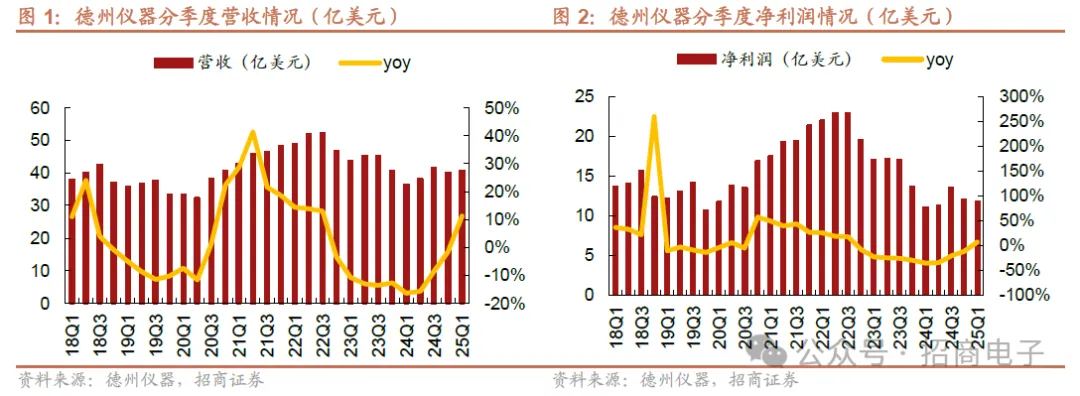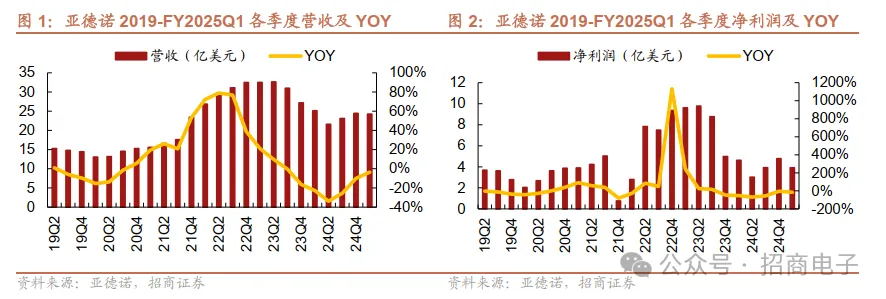How are TI and ADI, who are at the center of the storm, doing now?
01
From doubling the price to selling the goods as soon as they are needed, what have TI and ADI experienced?
Due to tariff implications, chips from U.S.-based TI and ADI have recently been in high demand.
However, after several weeks, the market has gradually calmed down from its initial chaos, and the spot market prices of TI and ADI have shifted along with overall market sentiment.
Looking back at key moments:
On April 10, China’s 84% tariff increase on U.S. imports officially took effect. Many chip distributors immediately suspended quotations.
On April 11, China announced a further tariff hike from 84% to 125%, leading to widespread quotation suspensions that lasted through the weekend (April 12-13).
Starting April 14, the situation changed—distributors gradually resumed quotations. Non-U.S. brands mostly quoted normally, while U.S. brands raised prices, with TI and ADI seeing the most significant increases.
By the week of April 21, the market began stabilizing. Although TI and ADI prices remained high, there appeared to be room for negotiation.
Examining the price trends of TI and ADI chips over the past few weeks:
In the first week after the tariff announcement, TI and ADI chips saw across-the-board price hikes, with high trading volume and extreme volatility.
Some distributors and customers, in no rush, held off purchases to observe the market. Others, driven by panic buying, asked distributors to secure inventory even at higher prices. There were even reports of bulk purchases of these brands in Huaqiangbei that week.
Leo, a distributor specializing in ADI, noted that during that week, "a day’s sales equaled a week’s worth."
Because of the "reserve" mentality, the more common the material, the more it rises.
Take TI's common common materials as an example: TL074IDR, the price remained at 0.4 yuan in February and March this year, and it has risen to 0.7 yuan in April; LM339DR, the price was 0.25 yuan in February this year, and there were quotations of 0.6 yuan in April, and the current quotation is 0.3 yuan before tax.
There have been complaints about the price increase of TI and ADI chips on various social platforms and industry groups.
Some people said that a TI material was still 4 yuan including tax on April 11, and it rose to 5.7 yuan including tax on April 14, but fortunately the customer accepted it.
Others said that the transaction price of ADI's AD7606 chip was less than 70 yuan before tariffs, and the lowest price after April 14 was 80 yuan, which has increased by at least more than 10%.
But starting from last week, TI and ADI's chips don't seem to be as "crazy" as before.
Before, Leo said that many people in Huaqiangbei should work overtime, hold meetings to buy goods or hold meetings to lock goods. "I asked multiple original manufacturers, agents, trades, and channels, and the mood is right. No one wants to sell. Even if the customer's demand is less than half of their own inventory, everyone is only willing to ship one-tenth of the goods."
But now, Leo said that although the performance is similar to before, the demand is gradually not keeping up, and the actual transaction price cannot be raised, "be cautious about pulling goods, and sell them when you want them." Another chip distributor also said that before "one minute should be 10 minutes", it can be felt that customers are obviously pulling goods, "quote a price, and let them deliver, and don't even talk about it", but last week, it feels that customers' inventory is decreasing.
Chip purchasing TT also said that although the quotations of TI and ADI have not dropped significantly for the time being, some prices are still very refreshing when they are negotiated with actual orders.
Overall, the market seemed to be "quiet" a little last week, but the price has not dropped significantly, and it is even a bit "chaotic". The specific transaction price can be negotiated based on the actual order.
02 Reasons for the change Why have TI and ADI’s chips become “quiet”?
First, the recent price surge of TI and ADI chips was primarily driven by tariff-induced market sentiment, triggering panic stockpiling among some customers.
On one hand, some clients placed urgent orders at higher prices to secure inventory. On the other hand, many distributors halted quotations, holding back stock in anticipation of further price hikes. Leo noted that inventories—agents’ warehouse stock, in-transit shipments from manufacturers, and factory reserves—could all be "locked up."
Tim, another distributor specializing in TI and ADI, added that most customers who could switch to domestic alternatives had already done so, while those who hadn’t were unlikely to change. This has fueled fears of shortages. Moreover, as imported chips rise in price, domestic substitutes often follow suit, enabling deals to close quickly even at doubled prices.
Additionally, some distributors mentioned that shipments stuck at Hong Kong customs are causing short-term supply gaps. Rather than paying the 125% tariff to clear imports, buyers prefer purchasing spot-market goods at a 50% premium.
However, after weeks of tariff effects, panic-driven demand has eased, with fewer urgent orders and stockpiling requests. While some hoard inventory for higher prices, others seize the opportunity to sell. One distributor noted offloading older stock, emphasizing that "liquidity trumps holding."
Meanwhile, TI and ADI shipments have begun trickling into China’s spot market via customs. Industry buzz late last week suggested some U.S.-origin chips avoided steep tariffs, prompting a reassessment of the tariffs’ market impact.
Amid these factors, TI and ADI prices have stabilized somewhat. Still, both brands remain more active than others in the spot market, with no significant price declines.
Though TI and ADI’s price surges share the same trigger, their situations differ slightly upon closer inspection.
TI’s 2024 annual revenue fell 11% YoY to $15.6 billion. Quarterly performance fluctuated post-Q4 2022 but trended downward overall, hitting a two-year low in Q1 2024 before a gradual recovery. Per its latest earnings, Q1 2025 revenue grew 11.1% YoY and 1.5% QoQ—marking its first YoY growth since Q4 2022.

TI said that the performance growth in the first quarter was mainly due to the fact that the three major terminals of the personal electronics market, enterprise systems and communication equipment are achieving year-on-year growth and showing a recovery trend, and the industrial market, which accounts for a large proportion, has also joined the ranks of recovery. This recovery can be seen from Q4 2024, and it has nothing to do with tariffs.
From the spot market, although TI's demand increased in the first quarter, it was more sensitive to prices, with more PPV demand, and more stringent requirements for supply standards (all standard products, all standard goods). The actual orders were small and it was still in "involution". Under the stimulus of this tariff, many chip distributors would rather seize this hard-earned opportunity to clear the inventory that has been piled up for a long time than to make money.
Although ADI's latest performance is still declining, it also indicates that it has entered a stage of sustained recovery.
ADI's latest first quarter results for fiscal year 2025 (ending February 1, 2025) show that revenue this quarter was US$2.423 billion, a year-on-year decrease of 3.6% and a month-on-month decrease of 0.8%. However, ADI saw an improvement in orders this quarter, with the order-to-billness ratio showing a positive trend. Order growth was driven by industrial and automotive, the company's two largest end markets. ADI has entered a phase of sustained recovery and 2025 is expected to be a year of growth.

From the spot market, ADI has had good news from time to time since last year.
Since the third quarter of 2024, ADI's chip circulation has become faster, and the market has warmed up slightly, and is in the recovery stage. At the end of last year, many friends said that they had obtained some orders from ADI. Friends who mainly deal in ADI have seen an increase in some terminal purchasing demands and found that ADI demand continues to grow.
However, after the New Year this year, some distributors said that although there are more orders from ADI, the overall demand is still unclear, and the growth momentum of general material demand is not high.
After this tariff, ADI's general materials have been affected by price increases. However, a supplier who mainly deals in ADI said that this time the price increase is a small part of the material number is a price increase, but most of it is actually back to normal, such as the goods that used to lose money and quoted at a flat price, and some old batches of goods, which began to be shipped with profits.
Last year, many general materials of ADI were shipped at a loss to clear inventory. Although there are still some materials with inverted prices now, they are definitely not as many as last year.
03
End Conclusion
Regarding the impact of this tariff, TI predicts that its revenue in the next quarter will not be affected. Its growth is only due to increased sales, which is the result of the recovery of
the industry cycle. In the spot market, most people see this as a short-term opportunity, and have different views on the long-term impact. Some chip distributors said that the
prices of TI and ADI will definitely fall in the future. But some people also said that even if the impact will not last for a few months, at least the overall market price will rise, not as
high as before, and the price can be recovered. How long can this wave of price increases last, and what do you think about it?







